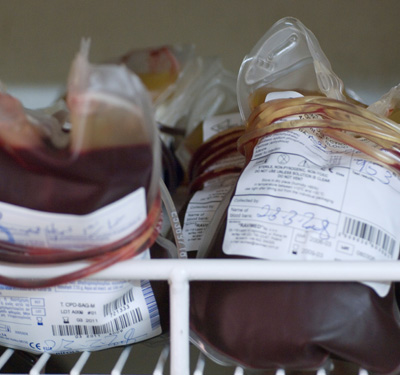The decision to transfuse
Understanding how physicians decide when to give trauma patients blood transfusions could aid in the development of evidence-based guidelines.
Published online 30 October 2016

Blood transfusions can be life saving; but they may be resorted to more often than needed.
Medicshots / Alamy Stock Photo
Emergency doctors resort to a variety of indicators – including blood pressure, heart rate, estimated blood loss and ultrasound results – to decide whether trauma patients need blood transfusion, reports a study published in the Journal of Emergency Medicine Trauma & Acute Care.
Researchers gathered data on 37 trauma patients who received blood transfusions at The Alfred Emergency & Trauma Centre in Melbourne, Australia. The attending emergency or trauma physicians filled questionnaires aimed at defining the reasons for each transfusion decision. Patient demographic, management and outcome data were also gathered from the centre’s registry.
The study aimed to understand how physicians decide to give blood transfusions to trauma patients. “It is important that transfusion is initiated based on accurate data so inappropriate transfusions are avoided,” write the researchers. Blood is both expensive and can sometimes lead to adverse outcomes even when only small volumes are transfused after trauma, they explain.
The team found that pre-hospital factors that influenced physicians to initiate transfusions once the patient arrived at hospital included a low systolic blood pressure, a fast heart rate, and loss of more than one litre of blood. Once in hospital, the most common factor leading to transfusion was a physician activating what is called a massive transfusion protocol, which is done when there is massive bleeding. Other in-hospital factors included ultrasound results that indicate accumulation of blood around the heart and/or abdominal organs, a low systolic blood pressure, a fast heart rate, and pallor.
A number of prediction scores for transfusion do exist but are not commonly used in clinical practice. Being able to predict which bleeding patients should receive blood transfusions and which ones could do without is an area of active research.
Employing computer technologies, or even smartphone apps, that have the ability to adjust predictions the more data is introduced could lead to more accurate predictions, the researchers say.
One main area of contention is how to estimate the amount of blood loss. One study estimated that only 24% of paramedics were within 50% of the actual volume of blood loss. Scoring systems that depend on developing a visual scale, suspecting a bleed as arterial or venous, and haemoglobin levels could improve estimations of pre-hospital blood loss, say the researchers.
Although only a small pilot study, it does provide some indication on the range of factors that are used by physicians to decide when to give a trauma patient a blood transfusion. Future research is needed to develop ways to improve blood loss estimation. Data from larger studies could inform evidence-based guidelines on indications for the initiation of blood transfusion after trauma, the researchers conclude.
Reference
- Ilancheran, A., Rahman, F., Mitra, B. Indications for blood transfusion following trauma – a pilot study. Journal of Emergency Medicine Trauma & Acute Care. | article
DOI: 10.1038/qsh.2016.134

